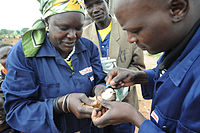
Photo from wikipedia
Due to the emergence of antibiotic resistance and new and more complex diseases that affect livestock animal health and food security, the control of epidemics has become a top priority… Click to show full abstract
Due to the emergence of antibiotic resistance and new and more complex diseases that affect livestock animal health and food security, the control of epidemics has become a top priority worldwide. Vaccination represents the most important and cost-effective measure to control infectious diseases in animal health, but it represents only 23% of the total global animal health market, highlighting the need to develop new vaccines. A recent strategy in animal health vaccination is the use of extracellular vesicles (EVs), lipid bilayer nanovesicles produced by almost all living cells, including both prokaryotes and eukaryotes. EVs have been evaluated as a prominent source of viral antigens to elicit specific immune responses and to develop new vaccination platforms as viruses and EVs share biogenesis pathways. Preliminary trials with lymphocytic choriomeningitis virus infection (LCMV), porcine reproductive and respiratory syndrome virus (PRRSV), and Marek’s disease virus (MDV) have demonstrated that EVs have a role in the activation of cellular and antibody immune responses. Moreover, in parasitic diseases such as Eimeria (chickens) and Plasmodium yoelii (mice) protection has been achieved. Research into EVs is therefore opening an opportunity for new strategies to overcome old problems affecting food security, animal health, and emerging diseases. Here, we review different conventional approaches for vaccine design and compare them with examples of EV-based vaccines that have already been tested in relation to animal health.
Journal Title: Viruses
Year Published: 2021
Link to full text (if available)
Share on Social Media: Sign Up to like & get
recommendations!